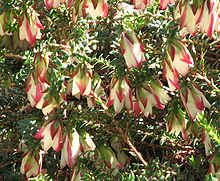- Darwinia macrostegia
-
Mondurup Bell 
Scientific classification Kingdom: Plantae (unranked): Angiosperms (unranked): Eudicots (unranked): Rosids Order: Myrtales Family: Myrtaceae Genus: Darwinia Species: D. macrostegia Binomial name Darwinia macrostegia
(Turcz.) Benth.Darwinia macrostegia, commonly known as Mondurup Bell, is a shrub which is endemic to a localised area near Albany in Western Australia. It usually grows to between 0.3 and 0.9 metres in height and produces red and white flowers between late autumn and late spring.[1] The species was first formally described by English botanist George Bentham in 1865 in Journal of the Linnean Society.[2] It occurs in the Stirling Range National Park in five separate populations.[3]
References
- ^ "Darwinia macrostegia". FloraBase. Department of Environment and Conservation, Government of Western Australia. http://florabase.dec.wa.gov.au/browse/profile/5515.
- ^ "Darwinia macrostegia". Australian Plant Name Index (APNI), IBIS database. Centre for Plant Biodiversity Research, Australian Government, Canberra. http://www.anbg.gov.au/cgi-bin/apni?TAXON_NAME=Darwinia+macrostegia. Retrieved 27 July 2011.
- ^ "Darwinia macrostegia (Mondurup Bell) Listing Advice". Advice to the Minister for the Environment and Heritage from the Threatened Species Scientific Committee (the Committee) on Amendments to the list of Threatened Species under the Environment Protection and Biodiversity Conservation Act 1999 (EPBC Act). http://www.environment.gov.au/biodiversity/threatened/species/pubs/4512-listing-advice.pdf. Retrieved 27 July 2011.
Categories:- Darwinia
- Rosids of Western Australia
Wikimedia Foundation. 2010.
